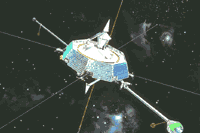Viking (Sweden)
 Sweden's first satellite, Viking, was originally initiated as a means of providing experience in satellite system development and management. The mission's scientific goal was to continue the work of a series of successful sounding rockets by investigating the interaction of the solar wind with the earth's magnetosphere and the behavior of the resulting aurora borealis. The vehicle's instruments returned a large quantity of data, and completely recorded the full cycle of auroral activity. The total project cost was approximately 20 million US dollars ($FY'86).
Sweden's first satellite, Viking, was originally initiated as a means of providing experience in satellite system development and management. The mission's scientific goal was to continue the work of a series of successful sounding rockets by investigating the interaction of the solar wind with the earth's magnetosphere and the behavior of the resulting aurora borealis. The vehicle's instruments returned a large quantity of data, and completely recorded the full cycle of auroral activity. The total project cost was approximately 20 million US dollars ($FY'86).
Spacecraft
Based on the USAF Small Scientific Satellites and NASA's Atmospheric Explorers. Spin stabilized at 3 rpm with torque rods. S-band downlink at 49.6 kbit/s data rate. Power from solar cells on spacecraft body totalling 2.2 square meters, providing 80 W average power. No onboard data storage.
Payload
V-1: Electric field - measured electric field. Experiment included 4 40m wire booms and two 4m rigid booms. V-2: Magnetic field - measured magnetic field using a 3-axis fluxgate magnetometer mounted on a
2m boom. V-3: Hot plasma and energetic particles - measured several different energy ranges with 7 different sensors. V-4L: Low frequency waves - Used 2 of the V-1 wire booms plus a magnetic coil antenna on a 2m rigid boom to measure electromagnetic waves between 0 - 15 kHz. V-4H: High
frequency waves - Used same sensors as V-4L to measure waves between 10 - 500 kHz. V-5: UV auroral imagers - imaged the Earth's aurora at UV frequencies between 1235A - 1600A and 1340A -
1800A.
| Country of Origin | Sweden |
| Customer/User | Swedish Space Corporation (SSC), Canada's Center for Space Science |
| Manufacturer(s) | Saab-Scania, Boeing |
| Size | 1.9m diameter, 50cm height |
| Orbit | 811 x 13,536 km, incl. = 98.8 degrees; 262 min period |
| Design Life | 8 months |
| Related Sites | The Viking Satellite |
Launch Facts
| Name | Int'l Desig. | Date | Site | Vehicle | Orbit | Mass(kg) |
| Notes | ||||||
| Viking | 1986-019B | 2/22/86 | Kourou | Ariane 1 | HEO | 538 |
| Studied magnetic, electric, UV properties of auroral regions | ||||||
Information in The Mission and Spacecraft Library is provided without warranty or guarantee. USE AT YOUR OWN RISK.